Scottish household survey 2018: annual report
Results from the 2018 edition of the continuous survey based on a sample of the general population in private residences in Scotland.
8 Physical Activity and Sport
Main Findings
In 2018 the vast majority of adults (80 per cent) had taken part in physical activity and sport in the previous four weeks.
Participation in all physical activity and sport remained relatively constant between 2007 and 2010 (around 72 per cent). Recently people had become more active (rising to 75 per cent in 2011 and to 80 per cent in 2018). The rise in physical activity was driven by the rise in recreational walking.
Recreational walking (for at least 30 minutes) has consistently been the most common type of physical activity. This has risen from 57 per cent in 2011 to 68 per cent in 2018.
Excluding walking, just over half (54 per cent) of the adult population participated in physical activity and sport in the four weeks prior to interview. This has remained broadly constant since 2007.
Frequent participation (on more than 14 days in the past four weeks) by those who were active has increased from 36 per cent in 2007 to 50 per cent in 2018.
Participation rates were higher among men than women (81 per cent and 78 per cent respectively).
Participation in physical activity and sport including walking declined with age.
Participation in physical activity and sport (including recreational walking) was lower for those living in deprived areas (69 per cent for those living in the most deprived areas compared to 90 per cent for those living in the least deprived). When walking is excluded, the gap between participation in the most deprived and least deprived areas has increased since 2007.
Ill health and disability had a big impact on participation. Those with a long term limiting condition were less likely to be physically active (39 per cent compared to 87 per cent of those with no condition).
Although the satisfaction with sports and leisure facilities of all respondents (including non-users) fell from 51 per cent in 2017 to 47 per cent in 2018, 83 per cent of sports and leisure facilities users in the past 12 months were very or fairly satisfied in 2018.
8.1 Introduction and Context
Physical activity and sport are a powerful force in transforming lives. There is clear and growing evidence of the health, economic and social benefits physical activity and sport can bring. Physical activity and sport improve the health of the heart, skeletal muscles, bones and blood, the immune system and nervous system, and enable people to live longer, healthier lives. Being active improves psychological wellbeing, boosts self-esteem, plays an important role in maintaining a healthy weight and improves mood and sleep quality.
Physical activity and sport can also play a major role in improving outcomes and tackling inequalities across many different aspects of our lives and society. Positive changes being achieved through physical activity and sport initiatives in Scotland include improving mental health, supporting weight management initiatives, overcoming loneliness and isolation; reducing reoffending; promoting sustainable forms of transport; and enabling people to connect with the natural environment[95].
The Active Scotland Delivery Plan, published in 2018, is one of five linked public health strategies and delivery plans which support the Public Health priorities[96]. Taken together, these aim to create a healthy environment whilst encouraging people to make good choices about their health, their life and their communities.
Questions on physical activity and sport participation were introduced in the SHS for the first time in 2007. The SHS questions cover levels and frequency of participation in physical activity and sport activities in the last four weeks prior to interview. From 2012 onwards, it is possible to obtain data at local authority level every year.
8.2 Participation in Physical Activity and Sport
8.2.1 Participation in Physical Activity and Sport in the Last Four Weeks
Figure 8.1 shows the percentage of adults who participated in physical activity and sports. In 2018 approximately four fifths of adults (80 per cent) participated in physical activity. The most prevalent activity by far was walking for at least 30 minutes (for recreational purposes), reported by 68 per cent of adults. If walking is excluded, over half of adults (54 per cent) participated in physical activity and sport. Participation in sporting activities ranged from two per cent (in bowls) to 17 per cent (swimming). Twenty per cent of adults reported that they had not participated in any sport or physical activity in the last four weeks.
Figure 8.1: Participation in sports and physical activity in the last four weeks
Percentage of adults, 2018 data (base: 9,700)
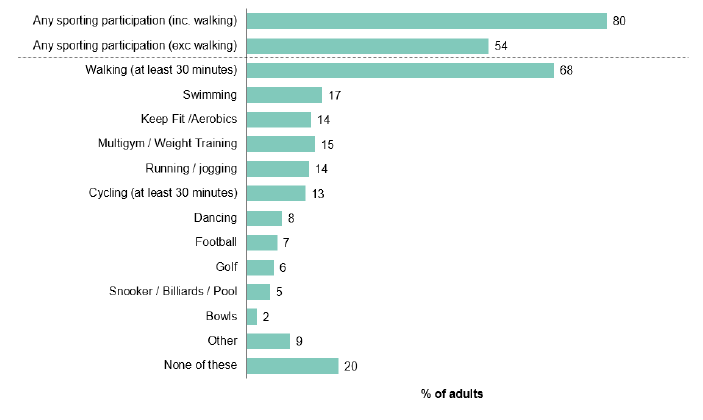
8.2.2 Participation in Physical Activity and Sport – Trends Over Time
Figure 8.2 and Table 8.1 show that participation in all physical activity and sport has been gradually increasing since 2010 from 72 per cent. In 2018, 80 per cent of adults reported participating in any activity in the last four weeks.
This increase was driven by a steady rise in the percentage of adults who walked for 30 minutes or more, from 54 per cent in 2010, to 64 per cent in 2014, and to 68 per cent in 2018. When recreational walking is excluded, participation in physical activity and sport remained relatively constant in the past decade, fluctuating between 51 and 54 per cent.
Figure 8.2: Participation in physical activity and sport in the last four weeks
Percentage of adults, 2007 to 2018 data (minimum base: 9,130)
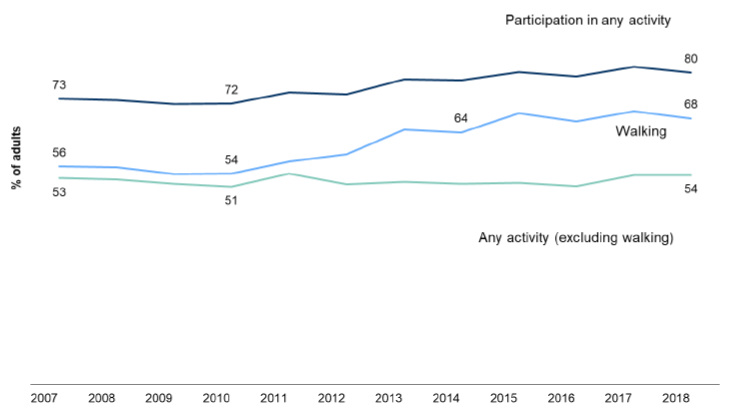
Table 8.1 shows that participation in different types of sport has seen changes over time between 2007 and 2018. Between 2007 and 2018, dancing has fallen in popularity (from 14 per cent to eight per cent). Likewise, the proportion of adults participating in activities such as bowls, snooker, and golf, has fallen during this time.
Other activities have become increasingly popular between 2007 and 2018. Participation levels all increased for cycling (from nine per cent to 13 per cent), multigym / weight training (from 11 per cent to 15 per cent), and running / jogging (from 10 per cent to 14 per cent).
Table 8.1: Participation in physical activity and sport in the last four weeks
Percentage of adults
| Adults | 2007 | 2008 | 2009 | 2010 | 2011 | 2012 | 2013 | 2014 | 2015 | 2016 | 2017 | 2018 |
|---|---|---|---|---|---|---|---|---|---|---|---|---|
| Any sporting participation (inc. walking) | 73 | 73 | 72 | 72 | 75 | 74 | 78 | 78 | 80 | 79 | 81 | 80 |
| Any sporting participation (exc walking) | 53 | 52 | 51 | 51 | 54 | 51 | 52 | 51 | 52 | 51 | 53 | 54 |
| Walking (at least 30 minutes) | 56 | 55 | 54 | 54 | 57 | 59 | 65 | 64 | 69 | 67 | 70 | 68 |
| Swimming | 19 | 19 | 17 | 17 | 18 | 17 | 17 | 18 | 17 | 16 | 18 | 17 |
| Keep Fit /Aerobics | 12 | 12 | 12 | 13 | 14 | 14 | 13 | 13 | 14 | 14 | 15 | 14 |
| Multigym / Weight Training | 11 | 11 | 11 | 11 | 12 | 12 | 12 | 12 | 13 | 14 | 15 | 15 |
| Running / jogging | 10 | 9 | 10 | 10 | 11 | 11 | 12 | 12 | 12 | 13 | 14 | 14 |
| Cycling (at least 30 minutes) | 9 | 9 | 9 | 9 | 10 | 10 | 11 | 11 | 12 | 11 | 12 | 13 |
| Dancing | 14 | 12 | 11 | 10 | 10 | 8 | 7 | 7 | 7 | 7 | 7 | 8 |
| Football | 9 | 8 | 9 | 9 | 8 | 7 | 8 | 7 | 8 | 8 | 7 | 7 |
| Golf | 9 | 8 | 8 | 7 | 8 | 6 | 7 | 6 | 6 | 6 | 5 | 6 |
| Snooker / Billiards / Pool | 9 | 9 | 8 | 7 | 7 | 5 | 6 | 5 | 5 | 6 | 6 | 5 |
| Bowls | 4 | 4 | 3 | 3 | 3 | 3 | 3 | 3 | 2 | 2 | 2 | 2 |
| Other | 9 | 10 | 6 | 8 | 10 | 10 | 10 | 9 | 9 | 9 | 8 | 9 |
| None of these | 27 | 27 | 28 | 28 | 25 | 26 | 22 | 22 | 20 | 21 | 19 | 20 |
| Base | 10,300 | 9,230 | 9,130 | 9,620 | 9,680 | 9,890 | 9,920 | 9,800 | 9,410 | 9,640 | 9,810 | 9,700 |
8.2.3 Frequency of Participation in Physical Activity and Sport – Trends over Time
Figure 8.3 shows that frequency of participation in physical activity and sport among participants has increased since 2007. The proportion of the population reporting frequent participation (on more than 14 days in the past four weeks) increased from just over a third (36 per cent) in 2007, to exactly half (50 per cent) in 2018. Given the relatively steady levels of participation shown in Figure 8.2, it would appear this increase in frequency of participation is due to individuals who are already active becoming more active.
Figure 8.3: Frequency of participation by adults who took part in physical activity and sport in the previous four weeks
Percentage of adults, 2007 to 2018 data (minimum base: 6,240)
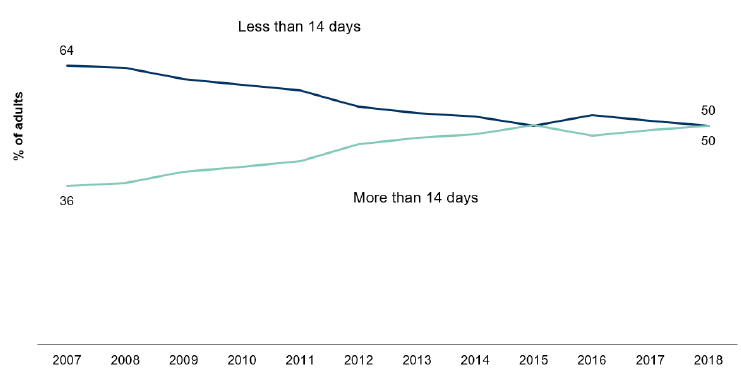
8.2.4 Participation in Physical Activity and Sport by Gender and Age
In 2018, overall physical activity and sport participation was higher for men than women (81 and 78 per cent respectively, as shown in Table 8.2). Gender differences were more pronounced for particular types of physical activity and sport.
The most common activity was recreational walking for both men and women, however the level of participation was lower for men than it was for women (66 and 70 per cent respectively).
When walking is excluded, the difference in participation between men and women is larger (59 and 49 per cent respectively). In particular, men participated more in multigym (19 and 11 per cent respectively), cycling (17 and nine per cent respectively), and football (12 and one per cent respectively). The activities in which men participated less than women included swimming (16 and 18 per cent), dancing (four and 11 per cent) and keep fit / aerobics (nine and 19 per cent respectively).
Participation in all physical activity and sport, including walking, declined with age (Table 8.2). The highest levels of participation were in the 25 to 34 year age group (89 per cent). This fell gradually to 81 per cent for those aged 45 to 59. The decline becomes more evident in the 60 to 74 and 75+ age groups where 73 per cent and 53 per cent of respondents engaged in physical activity in the past four weeks respectively.
When walking is excluded, the decline in participation with age was even more pronounced. Participation levels were highest for those aged 16-24 (68 per cent), decreasing among those aged 45-59 years (53 per cent) and further decreasing among those over the age of 75 (23 per cent).
Recreational walking levels were highest in the 35-44 age group at 75 per cent, and declined gradually to 43 per cent for those older than 75.
The popularity of different types of physical activity and sports varied with age. Football is one example, with 19 per cent of those aged 16 to 24 having participated in the previous four weeks compared to eight per cent of 35-44 year olds, and four per cent of 45 to 59 year olds. Multi-gym / weight-training and running showed similar patterns. Contrary to this, participation in swimming initially increased with age, peaking at around 27 per cent for 35 and 44 year olds and then declined from the age of 45.
Table 8.2: Participation in physical activity and sport in the past four weeks by gender and age group
Percentages, 2018 data
| Adults | Men | Women | Identified in another way | Refused | 16 to 24 | 25 to 34 | 35 to 44 | 45 to 59 | 60 to 74 | 75 plus | All |
|---|---|---|---|---|---|---|---|---|---|---|---|
| Walking (at least 30 minutes) | 66 | 70 | * | * | 66 | 74 | 75 | 72 | 66 | 43 | 68 |
| Swimming | 16 | 18 | * | * | 15 | 23 | 27 | 16 | 12 | 4 | 17 |
| Keep Fit /Aerobics | 9 | 19 | * | * | 15 | 18 | 19 | 14 | 11 | 6 | 14 |
| Multigym / Weight Training | 19 | 11 | * | * | 28 | 25 | 20 | 12 | 6 | 1 | 15 |
| Running / Jogging | 15 | 12 | * | * | 24 | 23 | 23 | 10 | 3 | 0 | 14 |
| Cycling (at least 30 minutes) | 17 | 9 | * | * | 15 | 15 | 18 | 16 | 7 | 2 | 13 |
| Dancing | 4 | 11 | * | * | 11 | 9 | 9 | 8 | 7 | 3 | 8 |
| Football | 12 | 1 | * | * | 19 | 12 | 8 | 4 | 1 | 0 | 7 |
| Golf | 11 | 1 | * | * | 6 | 6 | 6 | 6 | 7 | 5 | 6 |
| Snooker / Billiards / Pool | 9 | 2 | * | * | 11 | 8 | 6 | 4 | 2 | 1 | 5 |
| Bowls | 3 | 2 | * | * | 1 | 2 | 2 | 1 | 4 | 4 | 2 |
| Other | 10 | 9 | * | * | 8 | 14 | 10 | 10 | 8 | 5 | 9 |
| None of these | 19 | 22 | * | * | 13 | 11 | 13 | 19 | 27 | 47 | 20 |
| Any sporting participation (inc. walking) | 81 | 78 | * | * | 87 | 89 | 87 | 81 | 73 | 53 | 80 |
| Any sporting participation (exc walking) | 59 | 49 | * | * | 68 | 67 | 66 | 53 | 40 | 23 | 54 |
| Base | 4320 | 5380 | 0 | 0 | 680 | 1300 | 1370 | 2390 | 2540 | 1430 | 9,700 |
Columns add up to more than 100 per cent as multiple responses allowed.
8.2.5 By Age Groups Over Time
Figure 8.4, Figure 8.5 and Figure 8.6 show how physical activity and sport participation has changed over time for different age groups.
While fluctuations are evident, there is a definite upward trend in participation in physical activity and sport since 2007 for most age groups (Figure 8.4).
Figure 8.4: Participation in physical activity and sport (including walking) in the last four weeks over time by age group
Percentage of adults, 2007 to 2018 data (minimum base: 650)
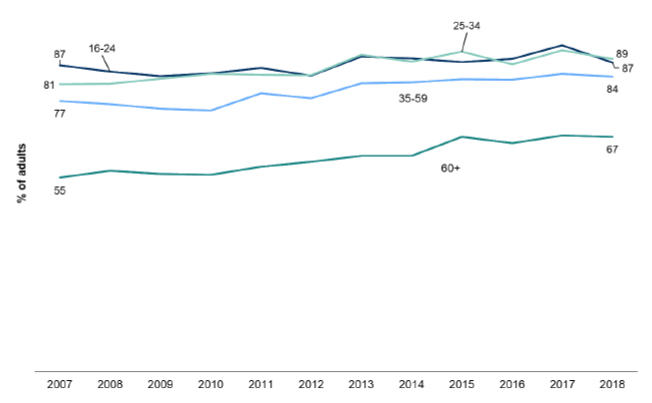
However, when walking is excluded (Figure 8.5), participation remained relatively stable for most age groups over time.
Figure 8.5: Participation in physical activity and sport (excluding walking) in the last four weeks over time by age group
Percentage of adults, 2007 to 2018 data (minimum base: 650)
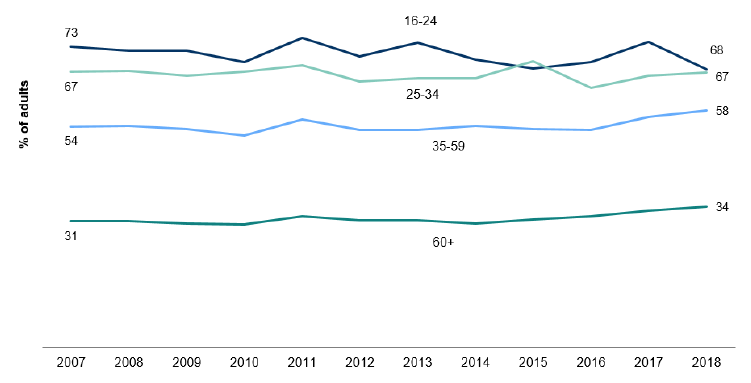
Figure 8.6 shows that the upward trend in recreational walking since 2011 has levelled off in 2018 for all age groups.
Figure 8.6: Participation in recreational walking in the last four weeks over time by age group
Percentage of adults, 2007 to 2018 data (minimum base: 650)
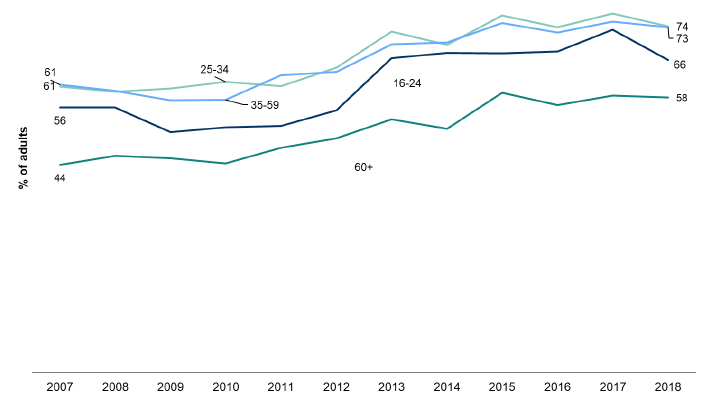
8.2.6 Participation in Physical Activity and Sport by Highest Level of Qualification
Figure 8.7 shows how participation in physical activity and sport varied with level of qualification. In 2018 participation was highest amongst those with a degree or professional qualification (91 per cent) and lowest for those with no qualifications (55 per cent).
When walking was excluded, the difference between qualification levels was even greater (69 per cent compared to 24 per cent). Walking was the most prevalent activity across the range of educational attainment but there was still a 32 percentage point gap in participation between those with a degree or professional qualification (79 per cent) and those with no qualifications (47 per cent).
Figure 8.7: Participation in physical activity and sport in the past four weeks by highest level of qualification
Percentage of adults, 2018 data (minimum base: 80)
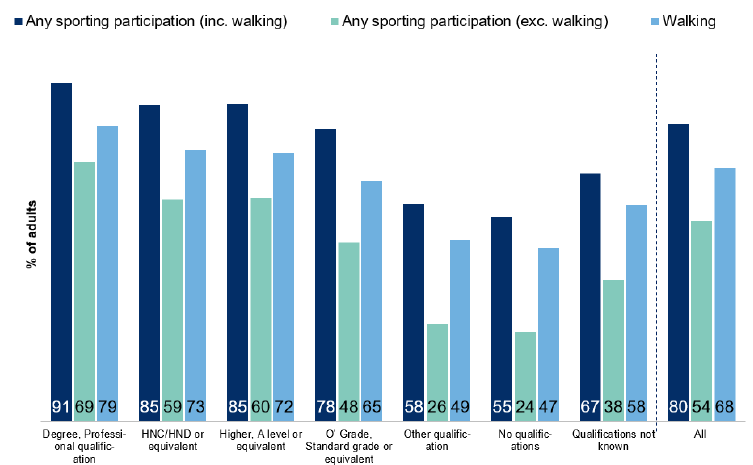
8.2.7 Participation in Physical Activity and Sport by Area Deprivation
Figure 8.8 shows how participation in physical activity and sport varied by area deprivation. Participation in the previous four weeks was lowest (69 per cent) among those in the 20 per cent most deprived areas of Scotland, compared with 90 per cent of those in the 20 per cent least deprived areas, as measured by the Scottish Index of Multiple Deprivation (SIMD). Participation excluding walking and participation in recreational walking followed the same pattern with more activity being associated with lower levels of deprivation.
Figure 8.8: Participation in physical activity and sport in the last four weeks by Scottish Index of Multiple Deprivation
Percentage of adults, 2018 data (minimum base: 1,770)
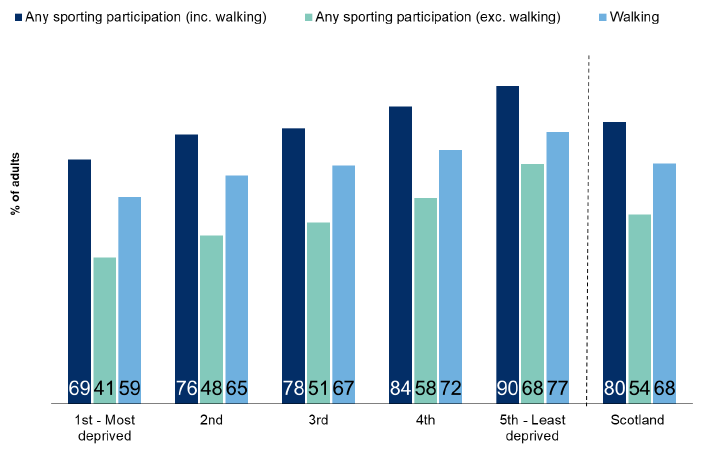
Table 8.3 shows participation in a range of different physical activity and sports by SIMD. This indicates that walking was the most popular activity irrespective of deprivation; however those in the least deprived areas participated substantially more than those in the areas of highest deprivation.
A similarly unequal pattern of participation was observed for swimming, keep fit, running, cycling and golf, whereas levels of participation in football, snooker, bowls and dancing were broadly similar between areas of both high and low deprivation.
Table 8.3: Participation in different types of physical activity and sport in the last four weeks by Scottish Index of Multiple Deprivation
Percentages, 2018 data
| Adults | Most deprived 20% | 2nd | 3rd | 4th | Least deprived 20% | Scotland |
|---|---|---|---|---|---|---|
| Walking (at least 30 minutes) | 59 | 65 | 67 | 72 | 77 | 68 |
| Swimming | 12 | 15 | 15 | 17 | 23 | 17 |
| Keep Fit /Aerobics | 11 | 11 | 12 | 16 | 21 | 14 |
| Multigym / Weight Training | 11 | 13 | 14 | 16 | 21 | 15 |
| Running / jogging | 8 | 11 | 12 | 16 | 20 | 14 |
| Cycling (at least 30 minutes) | 8 | 10 | 13 | 16 | 18 | 13 |
| Dancing | 8 | 7 | 7 | 8 | 9 | 8 |
| Football | 6 | 7 | 6 | 7 | 6 | 7 |
| Golf | 3 | 4 | 5 | 7 | 10 | 6 |
| Snooker / Billiards / Pool | 6 | 6 | 4 | 5 | 4 | 5 |
| Bowls | 2 | 2 | 2 | 2 | 2 | 2 |
| Other | 5 | 7 | 9 | 12 | 15 | 9 |
| None of these | 31 | 24 | 22 | 16 | 10 | 20 |
| Any sporting participation (inc. walking) | 69 | 76 | 78 | 84 | 90 | 80 |
| Any sporting participation (exc walking) | 41 | 48 | 51 | 58 | 68 | 54 |
| Base (minimum) | 1840 | 1850 | 2140 | 2100 | 1770 | 9700 |
Columns add up to more than 100 per cent as multiple responses allowed.
Figure 8.9 shows that the gap between participation in any sport and physical activity (including walking) in the 20 per cent most and 20 per cent least deprived areas has been consistent over time. The gap was 19 percentage points in 2007 (63 per cent and 82 per cent respectively) and 21 percentage points in 2018 (69 per cent and 90 per cent respectively).
Figure 8.9: Participation in physical activity and sport (including walking) in the last four weeks over time by Scottish Index of Multiple Deprivation[97]
Percentage of adults, 2007-2018 data (minimum base: 1,540)
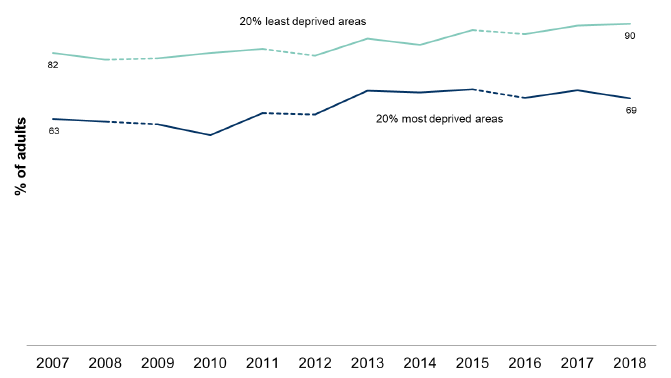
When walking is excluded, the gap between participation in the 20 per cent most deprived and 20 per cent least deprived areas increased from 19 percentage points in 2007 (44 per cent and 63 per cent respectively), to 27 percentage points (41 per cent and 68 per cent respectively) in 2018 (Figure 8.10).
Figure 8.10: Participation in physical activity and sport (excluding walking) in the last four weeks over time by Scottish Index of Multiple Deprivation[98]
Percentage of adults, 2007-2018 data (minimum base: 1,540)
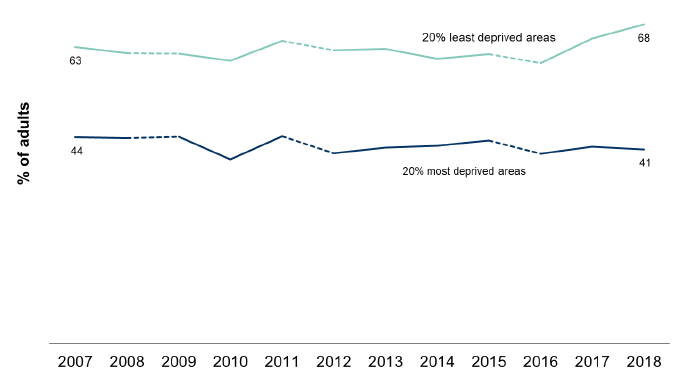
For recreational walking, the gap between participation in the 20 per cent most deprived and 20 per cent least deprived areas narrowed over time from 22 percentage points in 2007 to 18 percentage points in 2018 (Figure 8.11).
Figure 8.11: Participation in walking (at least 30 minutes) in the last four weeks over time by Scottish Index of Multiple Deprivation[99]
Percentage of adults, 2007-2018 data (minimum base: 1,540)
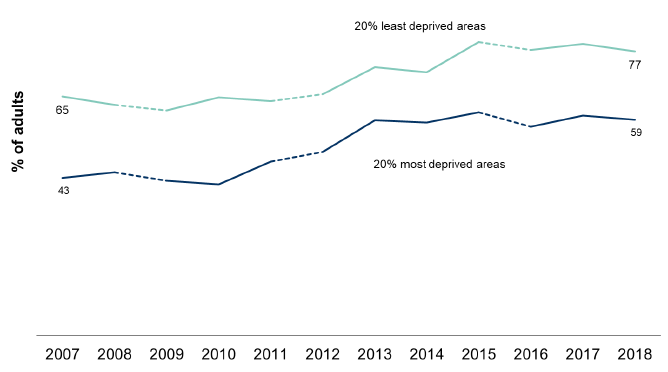
For those who did not participate in walking or sporting activities in the four weeks prior to the interview, the gap between the 20 per cent most and the 20 per cent least deprived areas increased from 18 percentage points in 2007 to 21 percentage points in 2018 (Figure 8.12).
Figure 8.12: Non-participation in physical activity and sport in the last four weeks over time by Scottish Index of Multiple Deprivation[100]
Percentage of adults, 2007-2018 data (minimum base: 1,540)
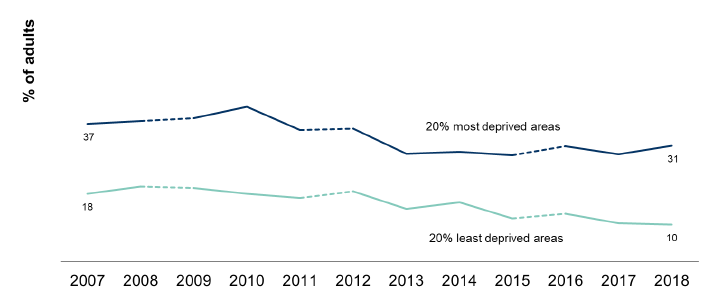
8.2.8 Participation in Physical Activity and Sport by Long-term Physical/Mental Health Condition
Figure 8.13 shows participation in physical activity and sport by long-term physical or mental health condition (lasting, or expected to last 12 months or more). Participation was lowest for those who reported a long-term condition which had a major impact on day to day activities (39 per cent), compared to 87 per cent participation for those with no condition. For those where the condition caused minor reduced daily capacity, the participation rate was lower at 72 per cent.
There was also a marked difference in participation in recreational walking between those with (32 per cent) and without longer-term physical and mental health conditions (74 per cent).
Figure 8.13: Participation in physical activity and sport in the last four weeks, by long-term limiting health condition
Percentages, 2018 data (minimum base: 1,250)
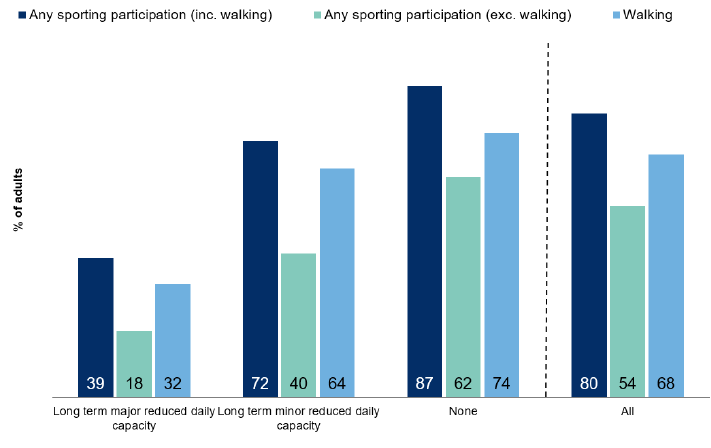
8.3 Satisfaction with Local Authority Cultural and Sports Services
Since 2007, questions have been asked in the Local Services suite of questions in the SHS on the frequency of use and satisfaction with local authority cultural and sport and leisure services. Table 8.4 presents the results for satisfaction with local authority sports and leisure services in 2018. It shows that levels of satisfaction amongst respondents (which include non-users) have been relatively constant since 2007 at around 50 per cent.
Between 2017 and 2018, there was a slight decline in the proportion of people who were satisfied with services, falling from 51 per cent to 47 per cent. This coincided with a rise in both the proportion of people who said they were ‘very/fairly dissatisfied’ (from five per cent to seven per cent), and those who said that they had ‘no opinion’ on leisure services (from 29 per cent to 33 per cent).
Table 8.4: Satisfaction with local authority sport and leisure services
Percentage of adults, 2007 to 2018 data
| Adults | 2007 | 2008 | 2009 | 2010 | 2011 | 2012 | 2013 | 2014 | 2015 | 2016 | 2017 | 2018 |
|---|---|---|---|---|---|---|---|---|---|---|---|---|
| Sports and leisure facilities | ||||||||||||
| Very/fairly satisfied | 50 | 50 | 48 | 49 | 51 | 51 | 53 | 52 | 51 | 50 | 51 | 47 |
| Neither satisfied or dissatisfied | 11 | 9 | 9 | 9 | 9 | 7 | 9 | 12 | 14 | 14 | 15 | 14 |
| Very/fairly dissatisfied | 9 | 8 | 8 | 8 | 8 | 5 | 6 | 5 | 5 | 5 | 5 | 7 |
| No opinion | 30 | 32 | 35 | 35 | 33 | 36 | 33 | 31 | 30 | 31 | 29 | 33 |
| Base | 10,220 | 9,240 | 9,710 | 9,020 | 9,660 | 9,890 | 9,920 | 9,800 | 9,410 | 9,640 | 9,810 | 9,700 |
Table 8.5 shows levels of satisfaction with local authority sports and leisure services, as above, but only amongst adults who used these services in the past year. In 2018, a large majority were very or fairly satisfied (83 per cent). This has been stable since 2011 but represents a small decrease compared to the years in between 2011 and 2017 (between 85 per cent and 88 per cent).
Table 8.5: Satisfaction with local authority culture and sport and leisure services. (Service users within the past 12 months only)
Percentage of adults, 2007 to 2018 data
| Adults | 2007 | 2008 | 2009 | 2010 | 2011 | 2012 | 2013 | 2014 | 2015 | 2016 | 2017 | 2018 |
|---|---|---|---|---|---|---|---|---|---|---|---|---|
| Sports and leisure facilities | ||||||||||||
| Very/fairly satisfied | 82 | 83 | 82 | 82 | 85 | 88 | 88 | 87 | 86 | 87 | 86 | 83 |
| Neither satisfied or dissatisfied | 7 | 6 | 6 | 6 | 5 | 5 | 5 | 5 | 6 | 5 | 6 | 7 |
| Very/fairly dissatisfied | 10 | 9 | 10 | 9 | 8 | 7 | 6 | 7 | 7 | 7 | 6 | 9 |
| No opinion | 1 | 1 | 1 | 2 | 2 | 1 | 2 | 1 | 1 | 1 | 2 | 2 |
| Base | 3,650 | 3,210 | 3,270 | 3,140 | 3,230 | 3,400 | 3,450 | 3,390 | 3,230 | 3,200 | 3,350 | 3,250 |
Contact
Email: shs@gov.scot
There is a problem
Thanks for your feedback